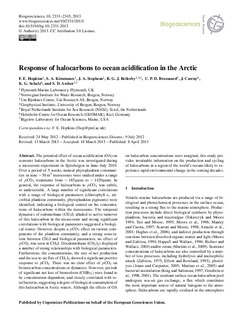| dc.contributor.author | Hopkins, Frances E. | |
| dc.contributor.author | Kimmance, Susan A. | |
| dc.contributor.author | Stephens, John A. | |
| dc.contributor.author | Bellerby, Richard | |
| dc.contributor.author | Brussaard, Corina P.D. | |
| dc.contributor.author | Czerny, Jan | |
| dc.contributor.author | Schulz, Kai G. | |
| dc.contributor.author | Archer, Stephen D. | |
| dc.date.accessioned | 2014-02-27T11:32:05Z | |
| dc.date.accessioned | 2014-03-25T13:55:08Z | |
| dc.date.available | 2014-02-27T11:32:05Z | |
| dc.date.available | 2014-03-25T13:55:08Z | |
| dc.date.issued | 2013 | |
| dc.identifier.citation | Hopkins, F.E.,Kimmance, S.A.,Stephens, J.A., et al., 2013. Response of halocarbons to ocean acidification in the Arctic. Biogeosciences 10(4):2331-2345 p. http://dx.doi.org10.5194/bg-10-2331-2013 | nb_NO |
| dc.identifier.issn | 1726-4170 | |
| dc.identifier.uri | http://hdl.handle.net/11250/192993 | |
| dc.description.abstract | The potential effect of ocean acidification (OA) on seawater halocarbons in the Arctic was investigated during a mesocosm experiment in Spitsbergen in June–July 2010. Over a period of 5 weeks, natural phytoplankton communities in nine ~ 50 m3 mesocosms were studied under a range of pCO2 treatments from ~ 185 μatm to ~ 1420 μatm. In general, the response of halocarbons to pCO2 was subtle, or undetectable. A large number of significant correlations with a range of biological parameters (chlorophyll a, microbial plankton community, phytoplankton pigments) were identified, indicating a biological control on the concentrations of halocarbons within the mesocosms. The temporal dynamics of iodomethane (CH3I) alluded to active turnover of this halocarbon in the mesocosms and strong significant correlations with biological parameters suggested a biological source. However, despite a pCO2 effect on various components of the plankton community, and a strong association between CH3I and biological parameters, no effect of pCO2 was seen in CH3I. Diiodomethane (CH2I2) displayed a number of strong relationships with biological parameters. Furthermore, the concentrations, the rate of net production and the sea-to-air flux of CH2I2 showed a significant positive response to pCO2. There was no clear effect of pCO2 on bromocarbon concentrations or dynamics. However, periods of significant net loss of bromoform (CHBr3) were found to be concentration-dependent, and closely correlated with total bacteria, suggesting a degree of biological consumption of this halocarbon in Arctic waters. Although the effects of OA on halocarbon concentrations were marginal, this study provides invaluable information on the production and cycling of halocarbons in a region of the world's oceans likely to experience rapid environmental change in the coming decades. | nb_NO |
| dc.language.iso | eng | nb_NO |
| dc.relation.uri | http://www.biogeosciences.net/10/2331/2013/bg-10-2331-2013.pdf | |
| dc.rights | CC by 3 - http://www.biogeosciences.net/general_information/license_and_copyright.html | |
| dc.rights.uri | https://creativecommons.org/licenses/by/3.0/ | |
| dc.subject | VDP::Matematikk og Naturvitenskap: 400 | nb_NO |
| dc.title | Response of halocarbons to ocean acidification in the Arctic | nb_NO |
| dc.type | Journal article | nb_NO |
| dc.type | Peer reviewed | nb_NO |
| dc.date.updated | 2014-02-27T11:32:06Z | |
| dc.rights.holder | © Author(s) 2013 | |
| dc.subject.nsi | VDP::Matematikk og naturvitenskap: 400::Geofag: 450::Oseanografi: 452 | |
| dc.subject.nsi | VDP::Mathematics and natural scienses: 400::Geosciences: 450::Oceanography: 452 | |
| dc.source.pagenumber | 2331-2345 | nb_NO |
| dc.source.volume | 10 | nb_NO |
| dc.source.journal | Biogeosciences | nb_NO |
| dc.source.issue | 4 | nb_NO |
| dc.identifier.doi | 10.5194/bg-10-2331-2013 | |
| dc.identifier.cristin | 1039858 | |
| dc.rights.license | Attribution 3.0 Unported (CC BY 3.0) | |

